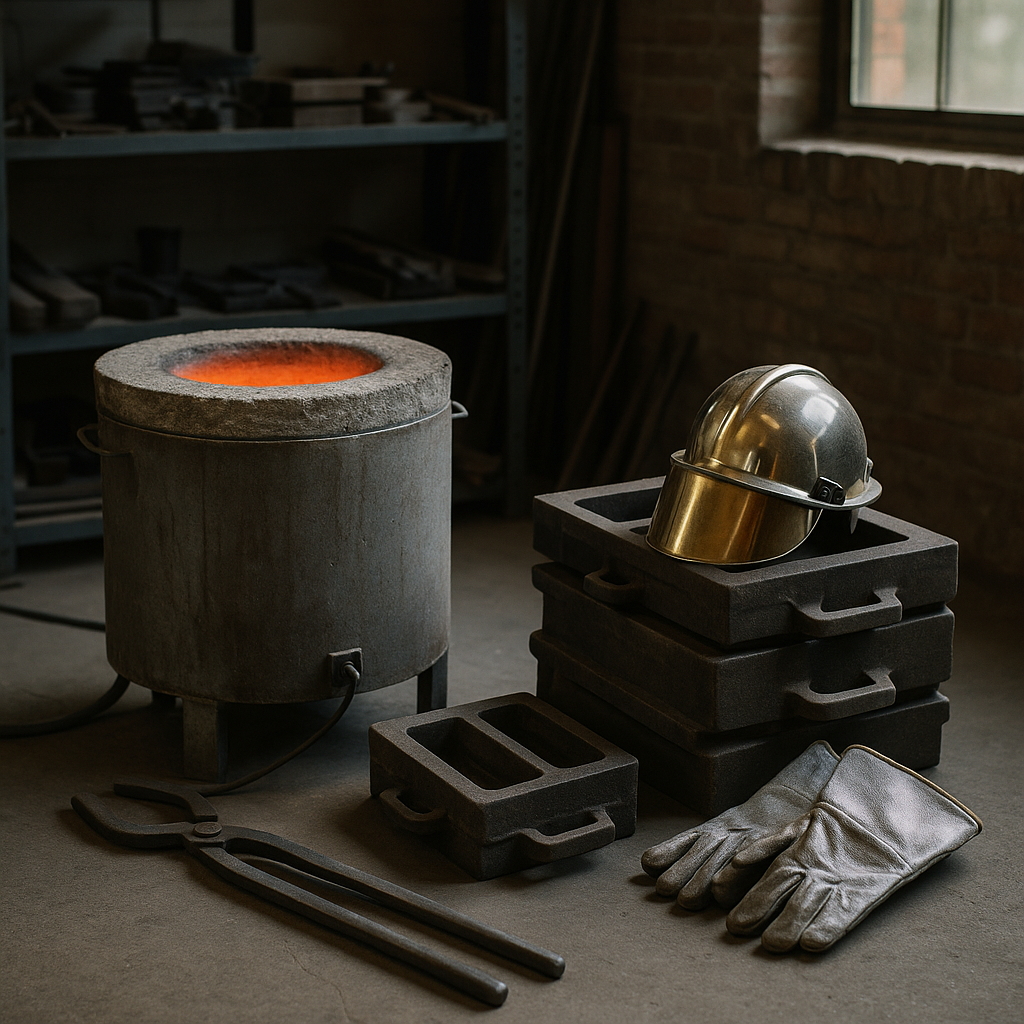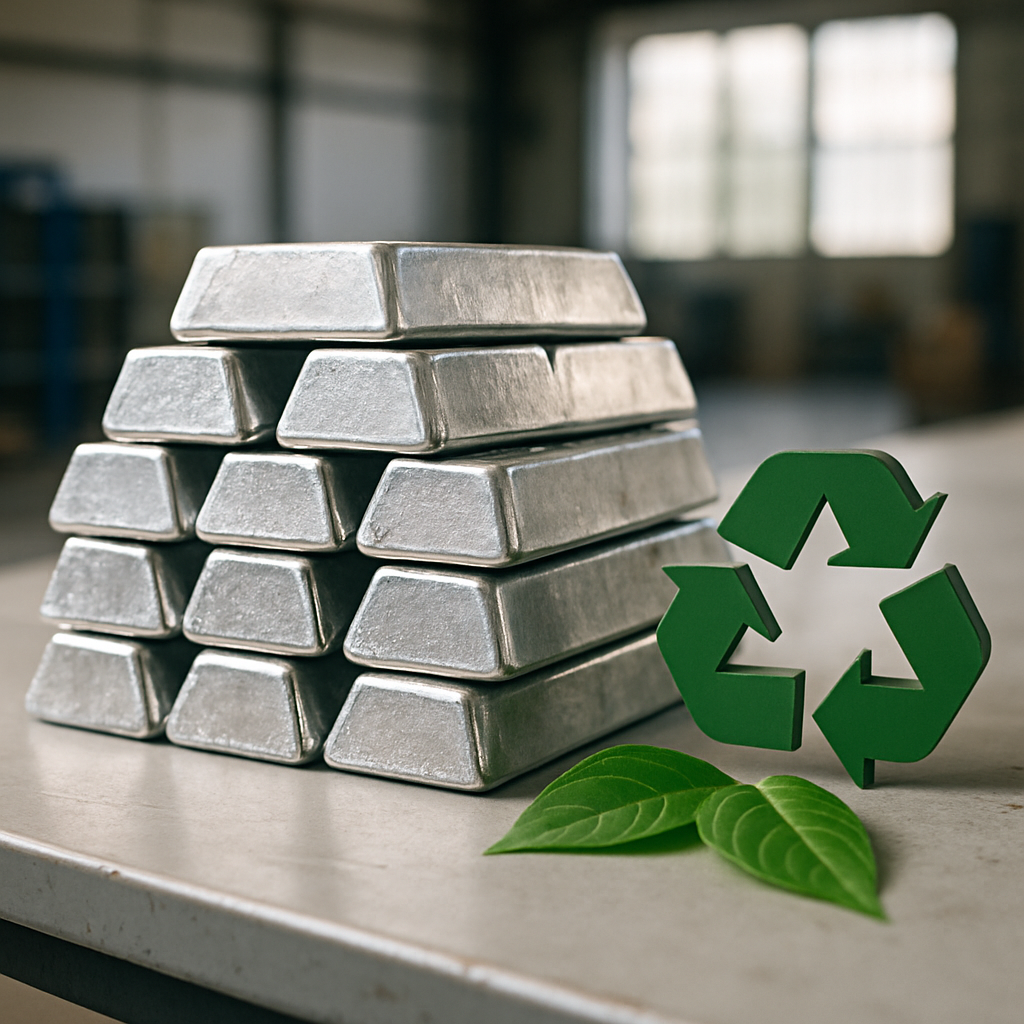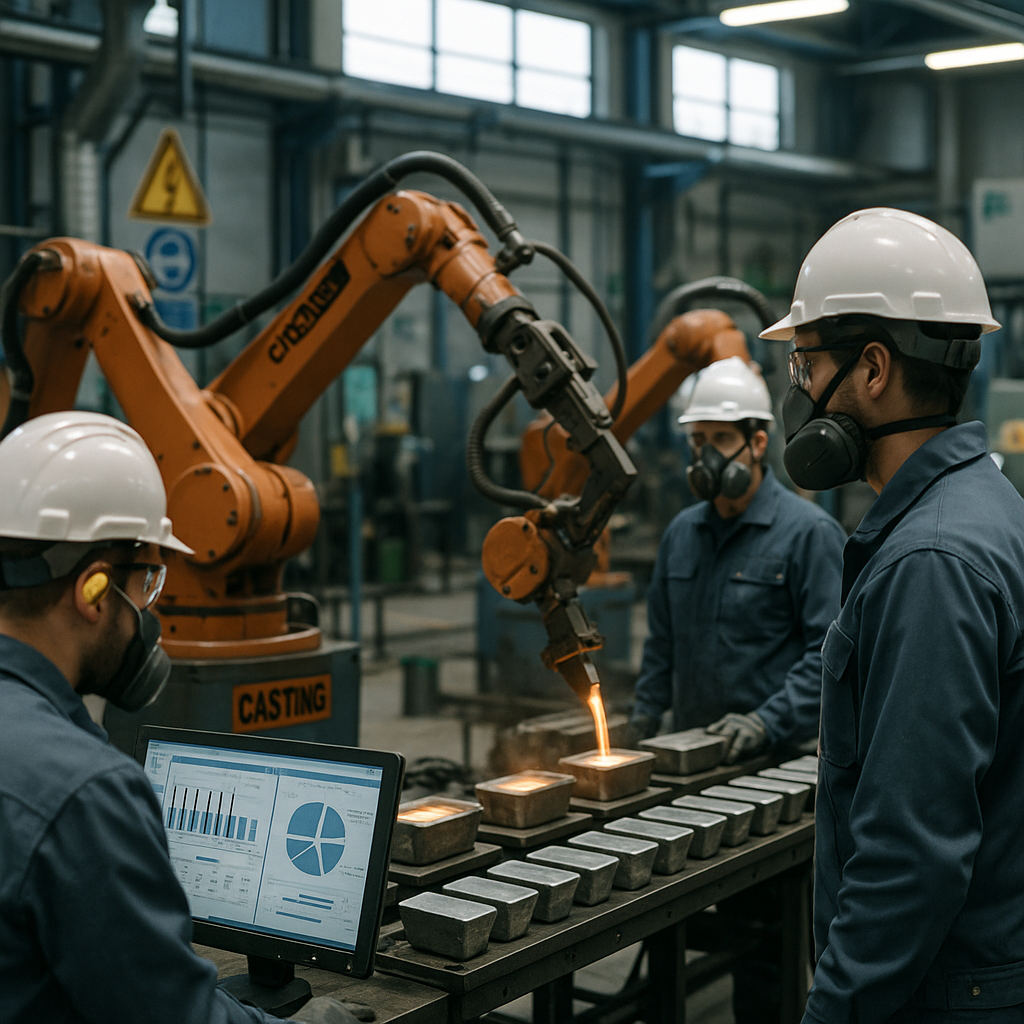5901 Botham Jean Blvd, Dallas, TX 75215
Scrap Metal Ingot Casting Process: Steps, Equipment, and Environmental Benefits
October 16, 2025As natural resources face increasing pressures, scrap metal recycling has become a cornerstone of sustainable manufacturing. The scrap metal ingot casting process transforms discarded metal waste into valuable raw materials for new products. This resource recovery system conserves our planet’s finite resources and significantly reduces the environmental impact associated with metal production.
At its core, the process converts what many consider waste into standardized metal forms called ingots. These solid blocks of metal serve as the building blocks for numerous products we use daily.
The transformation begins with the collection of metal waste from various sources like construction sites, manufacturing facilities, and household items. This material, otherwise destined for landfills, enters a carefully designed recycling stream.
What Are the Key Steps in Scrap Metal Ingot Casting?
Scrap metal ingot casting transforms discarded metal into reusable raw materials through a series of defined steps. This process combines traditional metallurgical techniques with modern industrial efficiency to produce standardized metal ingots for manufacturing.
Collection and Sorting
The process begins with collecting various scrap metals from industrial waste, construction sites, and recycling centers. Workers sort the metal by type and composition. This step is crucial because mixing incompatible metals can compromise the quality of the final product.
Sorting techniques range from manual inspection to advanced technologies like magnetic separation for ferrous metals. Non-ferrous metals such as copper, aluminum, and brass require separate processing streams due to their different melting points and chemical properties.
Proper identification ensures that similar metals are grouped together. This preparation maximizes efficiency in subsequent steps and reduces energy consumption during melting.
Size Reduction and Shredding
After sorting, large pieces of scrap metal must be reduced to manageable sizes. Industrial shredders cut and tear the metal into smaller fragments, increasing the surface area and allowing it to melt faster and more uniformly.
Metal shredders come in various designs, from hammer mills to rotary shears, depending on the type and volume of scrap being processed. Hardened steel components in these machines can withstand the extreme forces needed to break down tough metal pieces.
Size reduction also helps remove non-metallic attachments like plastic or rubber, which would otherwise interfere with the melting process and introduce impurities.
Melting in Furnaces
The shredded scrap enters large industrial furnaces where it is heated beyond its melting point. Different metals require specific temperature ranges. For instance, steel melts around 1370°C (2500°F), while aluminum liquefies at about 660°C (1220°F).
Several furnace types are used for this purpose. Electric arc furnaces use carbon electrodes to generate intense heat, while induction furnaces employ electromagnetic fields. Rotary furnaces rotate to ensure even heating of the metal charge.
The melting stage is the most energy-intensive part of the process. Recent innovations focus on improving thermal efficiency and reducing environmental impact, such as capturing heat from exhaust gases to preheat incoming scrap.
Purification and Refining
Molten metal contains unwanted elements that must be removed as these impurities can dramatically alter the mechanical properties of the final product. Purification methods vary by metal type but generally involve chemical treatments.
For steel, oxygen might be blown through the melt to burn off excess carbon. Aluminum often undergoes fluxing, using chlorine compounds to help separate out non-metallic inclusions. Skilled operators test samples throughout this stage to confirm chemical composition.
Purification ensures the final ingot meets industry specifications. This step transforms random scrap into a standardized material with predictable properties.
Casting Into Ingot Molds
The refined molten metal flows into prepared ingot molds, which come in standard shapes and sizes specific to the industry’s needs. Common configurations include rectangular blocks, cylindrical billets, or specialized forms.
Most ingot molds are made from cast iron or steel to withstand high temperatures. The interior surfaces may be coated with materials that prevent the metal from sticking. Proper mold design includes channels for gases to escape as the metal solidifies.
Automated casting systems allow for continuous production. Conveyor systems move empty molds into position while filled ones move to cooling stations, maintaining consistent production rates.
Cooling and Solidification
After casting, ingots must cool under controlled conditions. The cooling rate affects the metal’s internal structure and properties. Rapid cooling can create stresses, while slow cooling might allow unwanted segregation of elements.
Water spray systems often accelerate cooling while maintaining uniformity. Large production facilities use dedicated cooling beds where ingots rest until they reach a safe handling temperature. The solidification process takes minutes for small ingots but can extend to hours for larger masses.
During cooling, the metal transitions from liquid to solid, causing slight shrinkage, which mold designers account for in their specifications.
Final Inspection and Preparation
Quality control inspectors examine each ingot for defects. Surface inspections reveal cracks, porosity, or inclusions. Some facilities conduct non-destructive testing like ultrasonic scanning to detect internal flaws.
Ingots that pass inspection receive appropriate markings, identifying the material type, batch number, and often the composition. This identification ensures traceability throughout the supply chain.
Final preparation may include cleaning, packaging, or stacking for transportation. Ingots destined for rolling mills might undergo surface conditioning to remove oxides formed during cooling.
The finished ingots serve as feedstock for various manufacturing processes. They may be rolled into sheets, drawn into wire, or forged into components.
Through this structured process, scrap metal finds new life as standardized raw material, exemplifying circular economy principles. Materials that might otherwise end up in landfills instead become valuable industrial inputs.
What Equipment is Used for Scrap Metal Ingot Casting?

The transformation of scrap metal into valuable ingots requires specialized equipment designed for the unique challenges of recycling. Modern facilities use a coordinated system of machines that efficiently and safely sort, process, melt, and form metal ingots.
Metal sorting systems are crucial in the ingot casting process. These systems use magnetic separators, eddy current separators, and optical sorting to identify and separate different metal types. Proper sorting ensures higher quality finished ingots and reduces contamination.
Industrial shredders break down bulky scrap materials into manageable pieces before melting. These powerful machines can process everything from automotive scrap to manufacturing waste, increasing the surface area for more efficient melting while removing contaminants like oil, paint, or coatings.
Melting furnaces are central to any ingot casting operation. Reverberatory furnaces, which use reflected heat from the furnace roof, are common for aluminum recycling. Electric arc furnaces offer precise temperature control for metals with higher melting points. Induction furnaces provide energy efficiency for medium-scale operations processing non-ferrous metals.
Once melted, the liquid metal requires specialized handling equipment. Ladles and pouring systems transport the molten metal safely from furnaces to casting stations. Hydraulic tilting furnaces and automatic pouring arms have largely replaced manual pouring in modern facilities, reducing workplace hazards.
Ingot casting machines consist of mold conveyors or casting tables equipped with specially designed molds. Chain-type mold conveyors move the molds through the pouring, cooling, and demolding stages in a continuous process. Rotary casting tables offer another efficient solution for high-volume production.
Cooling systems control the solidification process through water spray tunnels or natural cooling zones. Proper cooling is essential for achieving the desired ingot quality and surface finish while preventing defects like cracking or porosity.
The final stage includes demolding and stacking equipment. Automated systems remove solidified ingots from molds and stack them using robotic or hydraulic systems, preparing them for strapping, labeling, and shipping.
Modern recycling facilities increasingly use automation throughout the process. Automated systems not only improve efficiency and throughput but also enhance workplace safety by reducing the need for workers to handle hot metals directly. For example, advanced ingot production lines can now monitor metal composition in real-time, adjusting furnace parameters automatically to maintain quality standards.
Environmental control systems complete the equipment lineup. Dust collectors, fume extraction systems, and emissions control technology ensure recycling operations meet regulatory requirements while minimizing environmental impact.
| Furnace Type | Primary Use | Advantages | Limitations |
|---|---|---|---|
| Cupola Furnace | Melting iron | Highly efficient and reliable for producing cast iron | Significant source of air pollution |
| Electric Arc Furnace (EAF) | Melting and refining scrap steel | Can recycle scrap steel, reduced need for new raw materials | High energy consumption, requires electricity |
| Induction Furnace | Melting various metals | High energy efficiency, faster heating times, better temperature control | Does not refine metal impurities |
| Crucible Furnace | Melting low melting point metals | Easy to use and maintain, cost-effective for small scale | Limited to low melting point metals |
| Blast Furnace | Production of pig iron | High production capacity, low cost | Major source of greenhouse gas emissions |
The integration of these specialized equipment components creates a complete ingot casting system capable of transforming various scrap metal streams into standardized, high-quality ingots ready for reuse in manufacturing. As technology advances, these systems become increasingly efficient, allowing recycling operations to process more material with less energy and environmental impact.
What Are the Benefits of Scrap Metal Ingot Casting?

Scrap metal ingot casting is a key component of sustainable manufacturing in our resource-conscious economy. This process transforms waste material into valuable resources, reintroducing them into the production cycle. The benefits extend beyond simple resource recovery.
Environmental Conservation
The environmental benefits of scrap metal ingot casting are significant and widespread. Recycling metal, instead of mining virgin ore, dramatically reduces the environmental footprint of metal production. Mining operations create large excavations that disrupt ecosystems and wildlife habitats.
Industry research indicates that recycling metal can reduce greenhouse gas emissions by up to 500 million tons, thanks to the lower energy requirements of recasting compared to mining and refining virgin ore.
Conserving natural resources is one of the most compelling benefits of ingot casting. Recycling one ton of steel conserves approximately 1.1 tons of iron ore, along with other minerals that would otherwise require mining.
Energy Savings and Reduced Emissions
The energy efficiency of scrap metal ingot casting is remarkable. Processing recycled metals demands far less energy than producing them from raw materials. For aluminum, the energy savings can reach as high as 95% compared to primary production methods.
These energy savings result in lower carbon emissions. By incorporating recycled metal ingots into production, the manufacturing sector can significantly reduce its carbon footprint, and the decreased energy demand also means reduced operational costs for metal producers.
Water conservation is another crucial benefit. Metal recycling uses up to 40% less water than traditional mining and refining operations, helping preserve local water supplies and reducing strain on municipal systems.
| Comparison Factor | Scrap Metal Recycling | Virgin Material Production |
|---|---|---|
| Greenhouse Gas Emissions | Up to 500 million tons less | Higher emissions due to mining and refinement processes |
| Energy Consumption | Saves up to 95% for aluminum, 60% for steel | Higher energy usage for extraction and processing |
| Water Usage | Up to 40% less water used | Significantly higher water consumption in mining and processing |
| Resource Conservation | Conserves natural resources like iron ore, coal, limestone | Requires extraction of virgin resources from the earth |
Economic Advantages
The economic benefits of scrap metal ingot casting extend throughout the supply chain. Manufacturers gain access to cost-effective raw materials, helping stabilize production costs even amid fluctuating market prices. This stability facilitates better long-term planning and more competitive pricing.
The recycling industry contributes significantly to the economy, adding nearly $117 billion annually in the U.S. and supporting over 500,000 jobs across collection, processing, and manufacturing. These jobs typically offer higher wages than those in waste management.
For businesses generating scrap metal, recycling generates an additional revenue stream instead of a disposal cost. Companies can sell unused or obsolete metal for recycling, offsetting expenses while contributing to sustainability.
Waste Reduction and Landfill Diversion
Scrap metal ingot casting plays a crucial role in waste management strategies. Metals in landfills can take centuries to decompose, potentially leaching harmful substances into soil and groundwater. Diverting metal from landfills prevents contamination from toxic elements like mercury and lead.
The recycling process keeps valuable materials in circulation instead of buried as waste, extending the useful life of metal resources indefinitely. Most metals can be recycled repeatedly without quality degradation.
Landfill space is at a premium in many areas. Metal recycling reduces the volume of waste needing disposal, aiding municipalities in managing waste more effectively and economically.
Supporting a Circular Economy
Scrap metal ingot casting exemplifies circular economy principles in action. Unlike the traditional take-make-dispose model, the circular approach keeps resources in use as long as possible, extracting maximum value before recovering and regenerating products at the end of their life.
Metals are well suited for this circular model because they maintain their essential properties regardless of the number of recycling cycles. This endless recyclability makes metal ingots a sustainable resource for repeated introduction into manufacturing.
By creating a closed-loop system for metals, ingot casting reduces reliance on volatile raw material markets, strengthening supply chains against disruptions and supporting more resilient manufacturing operations.
Conclusion: The Future of Scrap Metal Ingot Casting

Scrap metal ingot casting is at the forefront of sustainable metal production. This process reduces waste and provides valuable materials for global manufacturing supply chains. The recycling loop established through ingot casting is a key component of the circular economy model that industries worldwide are working to achieve.
As global metal demand increases, efficient recycling technologies are becoming essential. Innovations in AI-driven sorting systems, advanced melting furnaces, and precision casting techniques are already transforming the industry. These developments promise to enhance energy efficiency, environmental sustainability, and economic viability. For questions about recycling solutions or to learn more about sustainable metal management, contact Okon Recycling at 214-717-4083.
